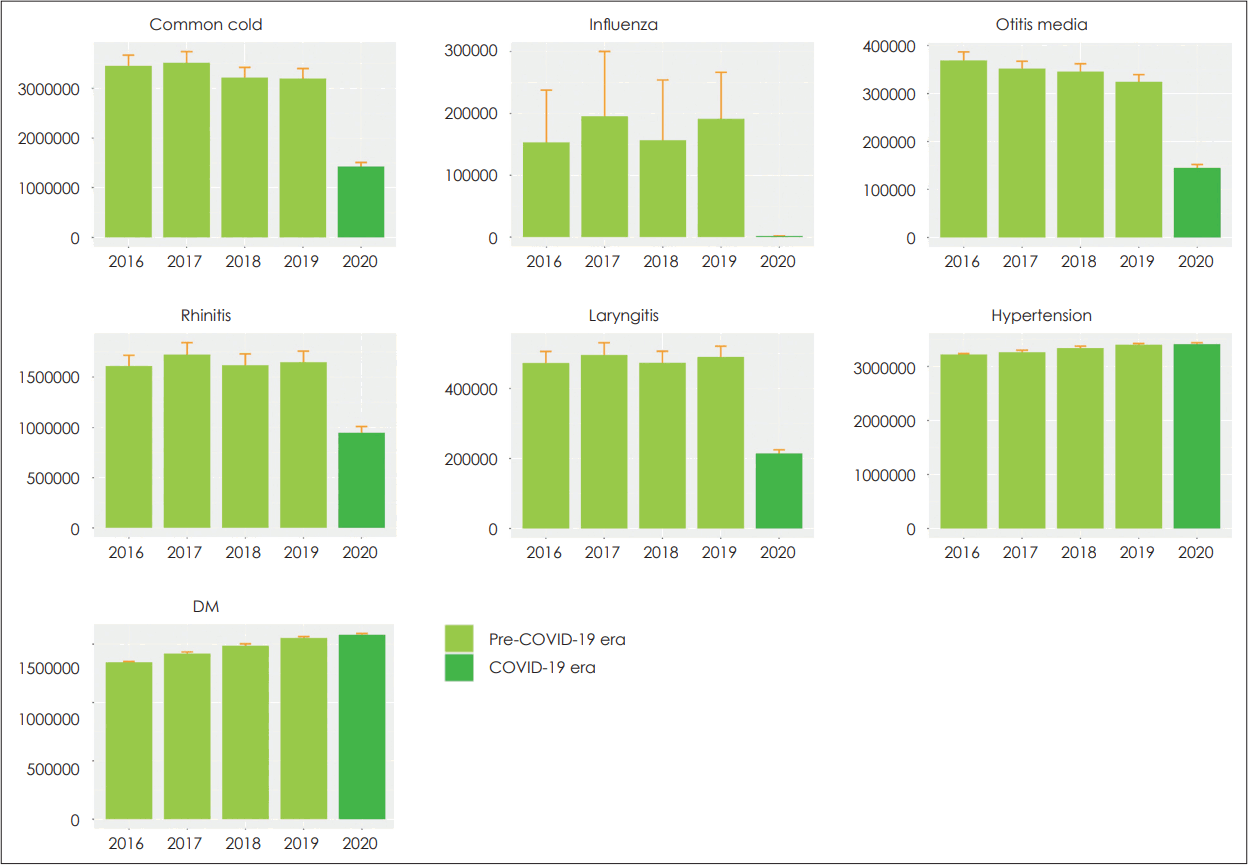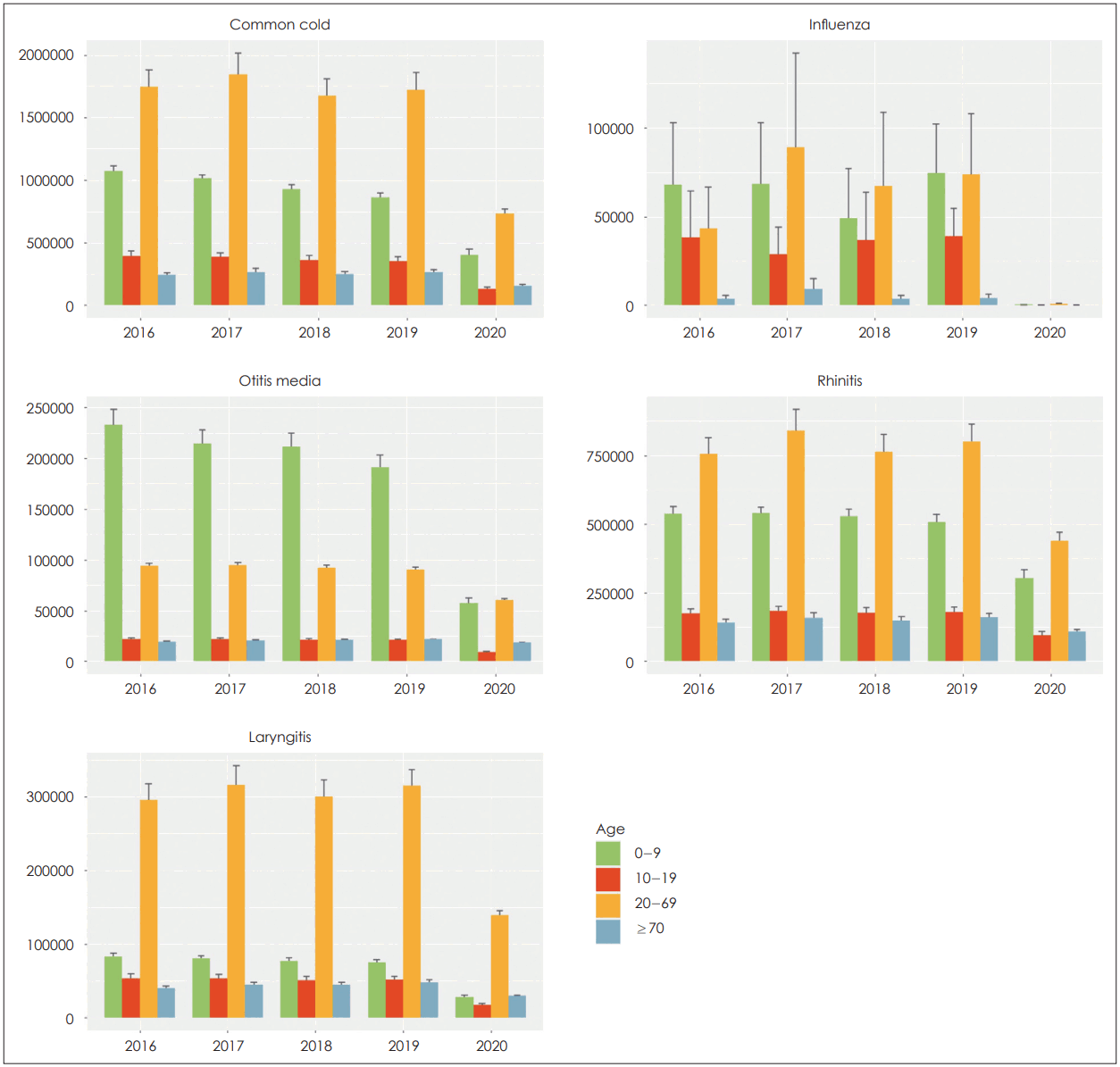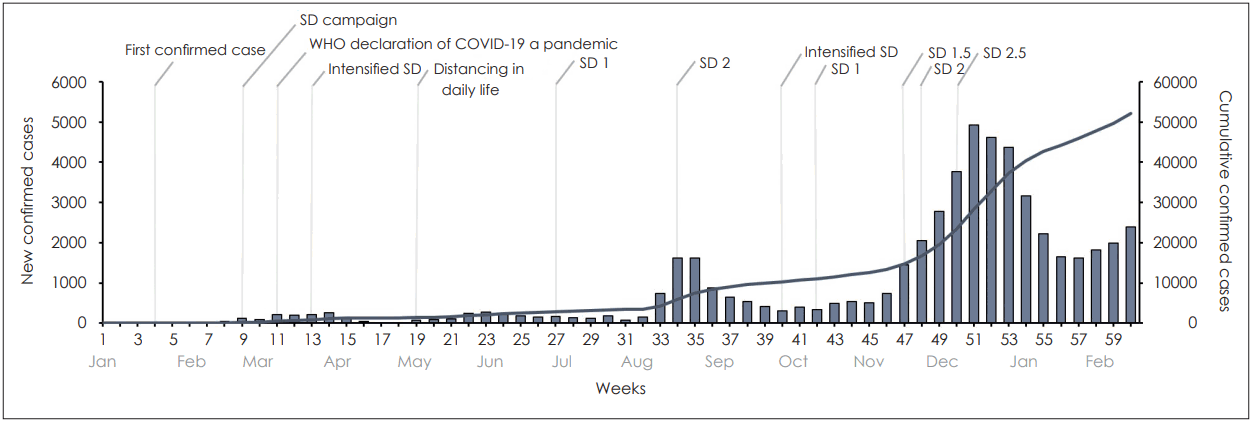COVID-19 유행 시 상기도 질환의 발생률: 전국 데이터 기반 역학 연구
Incidence of Upper Respiratory Diseases During the COVID-19 Pandemic: A Nationwide Data-Based Epidemiological Study
Article information
Trans Abstract
Background and Objectives
Nonpharmacologic interventions (NPIs), such as social distancing and preventive measures, were administered during the coronavirus disease (COVID-19) pandemic, which may influence the incidence of upper respiratory diseases (URDs). The present study compared the incidence of URDs during the COVID-19 pandemic and during the years prior to COVID-19, and investigated the effect of NPIs on URD in the nationwide general population.
Subjects and Method
This is an epidemiologic study based on the Korean National Health Insurance Database from March 2016 to February 2021. We compared the monthly incidence of URDs from March 2020 to February 2021 (12 months) with that of the past four years. A negative binomial regression model was used to evaluate the annual difference in the incidence of each URD and adjusting temperature, humidity, and the level of particulate matter 10 (PM10).
Results
The monthly incidence of ‘the five common URDs’ in 2020 was significantly lower than that in the past four years. The incidence of other chronic diseases, however, such as hypertension and diabetes mellitus, was comparable or higher in the past four years. Among the five common URDs, influenza virus infections decreased most dramatically, nearing 99%, from 296.4-377.1 per 100000 people during the period of 2016 to 2019 to 3.7 per 100000 people in 2020.
Conclusion
The present study shows that the incidence of ‘five common URDs’ significantly decreased during the era of COVID-19 in Korea. We believe that nationwide NPI might prevent the transmission of COVID-19 as well as other infectious sources associated with URDs.
Introduction
The World Health Organization declared a global pandemic of novel coronavirus disease (COVID-19) in March 2020 after the rapid dissemination of severe acute respiratory syndrome coronavirus 2 [1]. Before achieving herd immunity through vaccination, nonpharmacological interventions (NPIs), such as social distancing and preventive measures, play a major cautionary role; preventive measures to reduce infection spread include wearing masks, prioritizing handwashing, and practicing respiratory cough etiquette.
COVID-19 was first confirmed in January 2020 in South Korea, and the first wave appeared around Daegu City from February to March 2020. To prevent the rapid spread of COVID-19, preventive measures, such as wearing masks and prioritizing handwashing, have been strongly recommended by the government since February, and social distancing has been performed by the government since March 2020.
These active precautions might influence the reduction in COVID-19 as well as other respiratory infections. Previous studies have demonstrated that NPI decreases the risk of respiratory viral infection and illness [2-8]. During COVID-19, as NPI was performed worldwide, several studies reported the decreased prevalence of influenza virus (IFV) infection and other respiratory diseases [9-13]. Considering the seasonal and thermal effect on respiratory infection, at least 12 months during COVID-19 should be evaluated; however, studies evaluating the effect of upper respiratory disease (URD) during the first year of the COVID-19 pandemic are limited. This study aimed to compare the incidence of URDs during the COVID-19 pandemic with recent years before COVID-19 through the Korean National Health Insurance Database and evaluate the effect of NPIs on URDs.
Subjects and Method
This study was performed based on Healthcare Bigdata Hub that accumulates insurance claims due to a variety of common diseases from the Korean National Health Insurance Database by sex and age group, and the monthly incidence of diseases from March 2016 to February 2021 were used in this study. As NPIs have been performed since February or March 2020, we assumed that the effect started in March 2020. Next, we compared the mean value of the monthly patients with URDs from March 2020 to February 2021 (12 months) with the past 4 years. The monthly incidence of each disease was calculated. To consider environmental factors that influence the incidence of URDs, the monthly mean temperature, humidity, and particulate matter 10 (PM10) concentration of each month were adjusted [14]. The monthly mean temperature and humidity were obtained from the database of Korea Meteorological Administration (data.kma.go.kr), and PM10 concentrations were obtained from the database of Korea Environment Corporation (airkorea.or.kr). The number of COVID-19 cases and deaths were obtained from the Ministry of Health and Welfare of South Korea (ncov.mohw.go.kr).
Evaluation of URDs
We evaluated 5 common URDs: common cold, IFV infection, otitis media, rhinitis, and laryngitis. The diseases were defined using the International Classification of Diseases, 10th revision (ICD-10) in the Korean National Health Insurance Database. The Korean National Health Insurance Database defines the common cold as J00, J01, J02, J03, J04, J05, and J06; IFV infection as J09, J10, J11; otitis media as H65, H66, and H67; rhinitis as J00, J30, and J31.0; and laryngitis as J04, J05, and J37. To evaluate the possibility that people hesitated to visit clinics during the COVID-19 pandemic, diabetes mellitus (DM) (ICD-10 code E10-14) and hypertension (ICD-10 code I10-15) were used as reference diseases beyond URDs.
Nonpharmacological intervention (social distancing and preventive measures)
In response to the COVID-19 pandemic, universal use of facial masks was mandated, and other preventive measures, such as prioritizing handwashing and practicing respiratory cough etiquette, were strongly recommended by the government. In addition, social distancing at the national level started in March 2020, and the level of social distancing was controlled by the government according to the spread of COVID-19 (Fig. 1). Hence, the nationwide NPI was performed from March 2020.
Statistical analysis
Negative binomial regression was performed to evaluate the annual difference in the incidence each URD. Poisson or binomial models assume that each person has the same probability of an event. However, these probabilities vary person to person, day to day, and according to the daily amount of air pollutants and weather conditions resulting in overdispersion. Overdispersion is not an issue when the response variable is continuous and assumed to follow a normal distribution, as the variance parameter is estimated separately from the mean parameter. However, Poisson and binomial distributions define variance as a function of the mean, and overdispersion is not taken into consideration. Negative binomial, on the other hand, parameterizes mean µ and variance µ+γµ2 to account for overdispersion in the count observations [15]. For this reason, negative binomial regression was performed to evaluate the annual difference in the incidence of URDs after accounting for temperature, humidity, and PM10. Post hoc analysis was carried out using Tukey’s method [16]. In addition, we performed stratified analysis according to season, age group, and sex to evaluate the effect of the NPI on specific seasons or subgroups. The seasons were defined as March to May for spring, June to August for summer, September to November for fall, and December to February for winter. The monthly incidence per 100000 people for each disease were calculated. All statistical analyses were conducted using R for Windows version 4.0.3 (R Foundation for Statistical Computing, Vienna, Austria). The Seoul National University Hospital Institutional Review Board waived the need to obtain informed consents for this research (IRB waiver number E-2201-095-1290).
Results
The mean values of the monthly incidence of 5 common URDs, hypertension (HTN), or DM are shown in Fig. 2. The monthly incidence of URDs in 2020 was significantly lower than that in previous years when adjusting temperature, humidity, and PM10. However, the monthly incidence of other chronic diseases, such as HTN and DM, were comparable to or higher than those in previous years. Among the URDs, the incidence of the common cold, otitis media, and laryngitis in 2020 was less than half of the incidence in previous years. The incidence of rhinitis was 55%-58% that of other years. However, IFV showed the most dramatical decrease near 99% from 296.4-377.1 per 100000 people in 2016-2019 to 3.7 per 100000 people in 2020. The post hoc analysis for the negative binomial regression model is demonstrated in Supplementary Table 1.

Mean values for the monthly incidence of URDs, hypertension, and DM per 100000 people for the last 5 years, including the COVID-19 era (2020). As preventive measures and social distancing have been performed since February or March 2020, we assumed that the effect of those measures started in March 2020. The bar plot indicates the mean value of the monthly incidence of each URD, and the standard error is presented with an error bar. While the monthly incidence of patients with URDs in 2020 (COVID-19 era) was significantly lower than that in previous years (pre-COVID-19 era) when adjusting temperature, humidity, and particulate matter 10, the monthly incidence of patients with hypertension and DM were comparable to or higher than those in previous years. URD, upper respiratory disease; DM, diabetes mellitus.
Stratification by season, age, and sex was performed. All URDs occurred less frequently in summer from 2016 to 2019; however, the seasonal difference decreased in 2020 (Fig. 3). In contrast to 2016-2019, the incidence of URDs in winter was the lowest in 2020 among the seasons. The incidence of URDs were significantly lower in 2020 than the previous years except IFV infection. As IFV infection occurred in summer rarely, there was no significant difference in the incidence of IFV infection between the summer of 2020 and that of previous years, due to the seasonal aspects of the disease. Moreover, there was no significant difference in IFV infection between the fall of 2020 and that of 2016 or 2017. Surprisingly, the incidence of IFV infection in the fall of 2020 was higher than that in the winter of 2020 (3.7 per 100000 people versus 2.3 per 100000 people); this may be attributed to relatively weak NPI during fall in Korea. Whereas, the incidence of IFV infection was lower in winter and spring of 2020 than those of the previous years. In the stratified analysis by age, the monthly incidence of each URD was lower in 2020 than in the previous analysis for all age groups except rhinitis (Fig. 4). In the age group from 10-19 years, the incidence of rhinitis in 2020 was not significantly different from that in 2016. When stratifying by sex, the incidence of all URDs was lower in 2020 than the previous years in both males and females (Fig. 5).

Mean values for the monthly incidence of URDs per 100000 people according to the seasons. The monthly incidence of each URD for the last 5 years is shown. The bar plot indicates the mean value of the monthly incidence of each URD, and the standard error is presented with an error bar. URD, upper respiratory disease.

Mean values for the monthly incidence of URDs per 100000 people according to age group. The monthly incidence of each URD for the last 5 years is shown. Patients were classified into four age groups based on age characteristics: 0–9, 10–19, 20–69, and 70 or older. The bar plot indicates the mean value of the monthly incidence of each URD, and the standard error is presented with an error bar. URD, upper respiratory disease.

Mean values for the monthly incidence of URDs per 100000 people according to sex. The monthly incidence of each URD for the last 5 years is shown. The bar plot indicates the mean value of the monthly incidence of each URD, and the standard error is presented with an error bar. URD, upper respiratory disease.
Discussion
During the COVID-19 pandemic, preventive measures from droplets and social distancing were strongly recommended or mandated by the Korean government. In South Korea, the rate of wearing masks reached approximately 80% before the government-led mandate in February [17], and wearing masks was mandated on 13th October. Social distancing was performed on 22nd March while controlling for the intensity according to the spread of COVID-19. These responses might have caused a decrease in other respiratory diseases, such as the common cold and IFV infection.
In this study, we used a national health insurance database to evaluate the decrease in URD during the COVID-19 pandemic. As national health insurance covers all Korean people (approximately 51 million), this study included an enormous population. Significant decreases in the monthly incidence of URDs were found during the era of COVID-19. In contrast to URDs, the incidence of other chronic diseases, such as hypertension and DM, was comparable or increased during 2020, which indicates that the decrease in URDs was not caused by people’s hesitation to visit clinics or a shortage of medical manpower. Among the 5 URDs, the decrease in IFV infection was the largest. Interestingly, a previous study revealed that the decrease in IFV infection was larger than that in respiratory syncytial virus (RSV) during the 2020-2021 season of COVID-19 [18], although the infectivity of RSV is reported to be 0.9-1.8, which is similar to 0.9-2.1 of IFV [19-21]. It is difficult to explain that a larger decrease in IFV infection than RSV during the era of COVID-19. A possible explanation is that the effect of NPI on IFV infection is larger than RSV infection [18,22], although the pathomechanism has not been well-investigated. Therefore, the larger decrease in IFV infection than in other URDs might be caused by the different effects of NPIs on the pathophysiology of URD. The incidence of rhinitis in 2020 was 55%-58% of that in previous years, while the incidence of other URDs was less than half of that in previous years. This may be because “rhinitis” also includes allergic rhinitis, which is less affected by NPIs.
In the stratified analysis by seasons, interestingly, the seasonal difference in the incidence of URDs decreased in 2020. This may be because the different intensity of social distancing level influenced the incidence of the URDs. For instance, although URD is known to be more prevalent in winter than summer, the incidence of URDs in the summer of 2020 was higher than that in winter of 2020. Especially, IFV infection that dominantly occur in winter was less frequently occur in the winter of 2020 than the summer or fall of 2020. In Korea, as the number of daily patients with COVID-19 infection was less than 100 from April to the beginning of August 2020, social distancing level 1 was maintained until the first week of September. However, after the 2nd outbreak in August, social distancing level 2 was performed from September to October. In addition, social distancing level 2.5 was performed from November due to the 3rd outbreak. A low level of social distancing in summer might have decreased the seasonal difference in the incidence of URD in 2020.
Not surprisingly, the spread of infectious URD decreased as a result of NPI, and this study demonstrated the extent of the decreases in common URDs compared with the most recent 4 years. A previous meta-analysis revealed that mask wearing provided a significant protective effect against IFV (odd ratio [OR]=0.55) and severe acute respiratory syndrome (OR=0.26) [23]. In addition, a meta-analysis reported that hand washing decreased the risk of respiratory infection by 16% in children or young adults [24]. While other studies commonly focused on influenza infection or respiratory symptoms rather than certain respiratory diseases, the present study demonstrated that the diagnosis of URDs caused by respiratory infections, such as otitis media and laryngitis, also decreased. In addition, as nationwide mandatory NPI was not enforced before the COVID-19 pandemic, only studies for recommended NPIs for certain populations were performed. The COVID-19 pandemic allows natural experiments to investigate the effect of NPIs on URD in the nationwide general population.
The present study has some limitations. First, because this study was based on a nationwide database with ICD-10 codes, the details for URD were not analyzed; information for acute or chronic status was not provided. However, as acute infection of the upper respiratory tract is a common cause for visiting the clinic among patients with chronic URD, acute and chronic URD might be closely related. Second, in addition to NPIs, some factors associated to COVID-19 pandemic might decrease URDs. Some people may hesitate to visit hospitals with URDs, and they may buy generic drugs in pharmacies or expect natural recovery. Hence, we also evaluated hypertension and DM during the study period as references to chronic diseases that are not affected by NPIs. Moreover, we adjusted for temperature, humidity, and PM10 concentration in a negative binomial model to account for confounders. To our knowledge, this is the first study to compare the incidence of URDs during the era of COVID-19 to that during other recent years. In addition, the present study has strength in its large study population, as a nationwide database was used.
In conclusion, the present study shows that the incidence of URDs was significantly decreased during the era of COVID-19 in Korea. We believe that nationwide NPIs in Korea might prevent the transmission of COVID-19 as well as other infectious sources associated with URD.
Supplementary Material
The Data Supplement is available with this article at https://doi.org/10.3342/kjorl-hns.2022.00101.
Acknowledgements
None
Notes
Author Contribution
Conceptualization: Jin Youp Kim, Yun-Sung Lim, Hae Ju Yang. Data curation: Hyeryeong Choi, Hae Ju Yang, Min Ji Hong. Formal analysis: Jin Youp Kim, Su Hwan Kim, Hyeryeong Choi, Hae Ju Yang. Methodology: Jin Youp Kim, Su Hwan Kim. Project administration: Jin Youp Kim, Hae Ju Yang. Resources: Hae Ju Yang. Software: Hyeryeong Choi, Min Ji Hong. Supervision: Hae Ju Yang. Validation: Jin Youp Kim, Su Hwan Kim. Visualization: Jin Youp Kim, Hyeryeong Choi, Hae Ju Yang, Min Ji Hong. Writing—original draft: Jin Youp Kim, Su Hwan Kim, Hyeryeong Choi, Hae Ju Yang, Hyung-Jin Yoon. Writing—review & editing: Yun-Sung Lim, Hyung-Jin Yoon.

